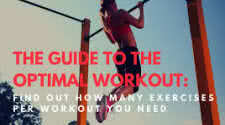Optimal Workout - Optimal Duration, Split and Workout Plan

Working out is far more involved than simply lifting weights - find out more below.
Dateline, World Gym, Tuesday afternoon. Chest and triceps day. While taking a 10-second break to grab some water, I heard the following exchange between two rather skinny
individuals who were furiously pedaling away on Lifecycles:
Person 1: "So, you gonna do some lifting when you're done on the bike?"
Person 2, shaking his head vigorously: "Naw. 1 hear lifting is bad for your heart."
Incredible! I'm not sure what somebody who believes that was doing at World, but it got me thinking that even those who don't believe it may be interested in what heavy
lifting does to the old ticker and related systems.
All forms of exercise, when pursued vigorously, result in physiologic changes to the body. The type and extent of these changes depend on the type of exercises performed and
the vigor with which they are pursued.
Weight training is no exception. Whether as the main focus or as an adjunct to other forms of exercise, weight training results in characteristic changes in the body. The
type and extent of these changes depend on the type of weightlifting and the vigor with which the weights are lifted.
What changes occur? How do they differ from changes seen in aerobic training? What happens to heart rate, blood pressure and oxygen consumption? Are these changes good or bad?
The Aerobic Heart
The cardiac changes seen with weight training are considerably different from those seen with aerobic conditioning. In aerobic conditioning (running, bicycling and swimming, for example) the demand for oxygen delivery is increased. This translates into a demand for the heart to pump more blood per minute in order to deliver more oxygen. If the demand for increased oxygen delivery is high enough over a long enough period of time, the cardiac tissue changes by increasing ventricle cavity size; that is, increasing the diameter of the heart's main pumping chambers.A bigger ventricle can pump more blood with every stroke (increased stroke volume); therefore, at a given heart rate more blood gets pumped per minute (increased cardiac output), and more oxygen gets delivered to the tissues. (To keep a big-chambered heart from pumping too much blood at rest, the resting heart rate goes down. That's why highly aerobically trained athletes often have resting heart rates in the 40s.)
The Anaerobic Heart
For the bodybuilder the demands on the heart are quite different. Instead of needing to increase oxygen delivery for prolonged periods of time, the heart needs to increase its ability to pump against high resistance for very short periods of time.During a lift your blood pressure may go as high as 280/350. While your heart needs to sustain such incredibly high pressures for only short periods of time, these high pressures still place considerable demand on the heart. If this demand occurs repeatedly over a long-enough period of time, the cardiac tissue changes by increasing ventricle wall thickness without changing chamber size. A thicker ventricle pumps the same amount of blood with every stroke but can generate a much greater pressure when needed.
These heart changes, both in aerobically trained and in weight-trained athletes, come on fairly quickly- measurable differences have been noted in as little as one week. It appears, however, that these changes persist only as long as the training continues. If training is stopped, the heart thickness and chamber sizes eventually return to pre-training dimensions.
Blood Pressure
As mentioned above, during a lift blood pressure can reach very high levels. Blood pressure is related to the amount of weight lifted and the muscle mass involved, and it increases with every rep, reaching the highest levels when submaximal lifts are repeated to failure. The rise appears to be significantly less in experienced bodybuilders than in inexperienced bodybuilders. Other than the momentary increases during a lift, however, weightlifting does not seem to increase baseline blood pressure. In fact, there is some evidence that weightlifting may actually decrease baseline blood pressure. Chalk up another one for iron!Heart Rate
Resting heart rate is unchanged in weight-trained athletes. This contrasts with aerobically trained athletes, who show a decrease in their resting heart rates. During a 10-to-12-rep max set a trained lifter's heart rate increases to 80 to 85 percent of the maximum heart rate attainable during aerobic activity. This increase is a result of a combination of neural and hormonal influences, but the heart rate quickly returns to normal once the exertion is stopped.When trained lifters lift to exhaustion, they have higher heart rates and lactate levels than untrained subjects, but they recover more quickly. This is attributable not only to the fact that by the time they reach exhaustion trained weightlifters have performed more work, but also that they have well-developed fast glycolytic systems. This means that by training they have geared up the muscle glucose-metabolism machinery so that their muscles can metabolize a greater amount of glucose in a shorter period of time. This is similar to glucose-metabolism changes seen in aerobically trained athletes.